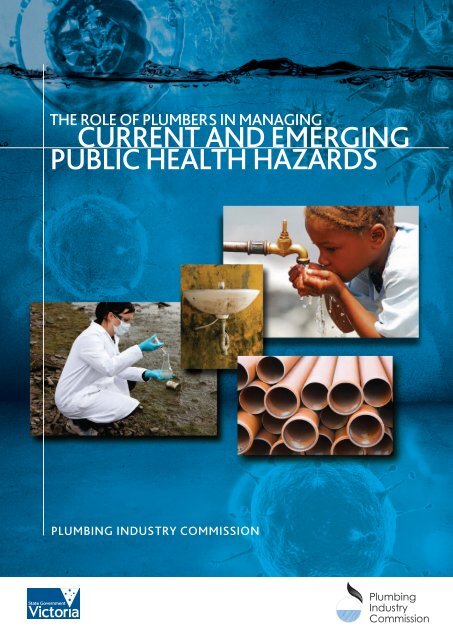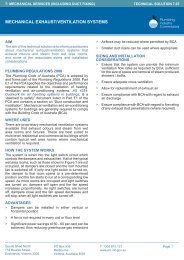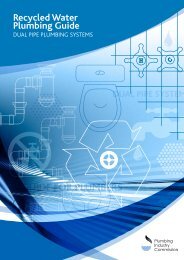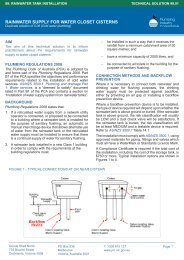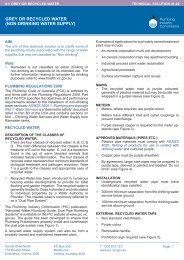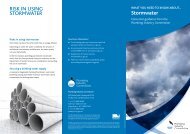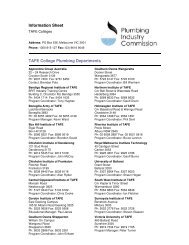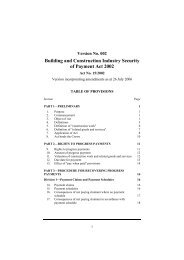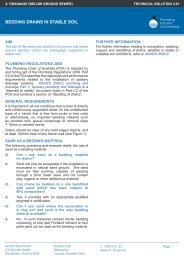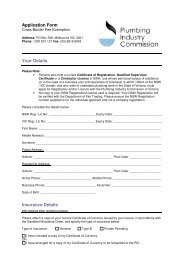current and emerging public health hazards - Plumbing Industry ...
current and emerging public health hazards - Plumbing Industry ...
current and emerging public health hazards - Plumbing Industry ...
You also want an ePaper? Increase the reach of your titles
YUMPU automatically turns print PDFs into web optimized ePapers that Google loves.
THE ROLE OF PLUMBERS IN MANAGINGCURRENT AND EMERGINGPUBLIC HEALTH HAZARDSPurposeHighlight the role plumbing plays in preventing<strong>public</strong> <strong>health</strong> <strong>hazards</strong>.ConsultationSteve Hrudey, Hrudey S <strong>and</strong> Hrudey E, SafeDrinking Water, Lessons from Recent Outbreaksin Affluent Nations, Department of Public HealthSciences, Faculty of Medicine <strong>and</strong> Dentistry,University of Alberta, Edmonton, AB, Canada,IWA Publishing, 2004.Victorian Department of Health: DavidSheehan, Manager, Drinking Water Regulation,Environmental Health Unit, Health ProtectionBranch, Department of Health.The <strong>Plumbing</strong> <strong>Industry</strong> Commission thanksthe Department of Health for their support<strong>and</strong> contribution towards the developmentof this <strong>public</strong>ation.Note: Every endeavour has been made to ensure the research findings referred to in this document are themost recently available at the time of <strong>public</strong>ation.2
THE ROLE OF PLUMBERS IN MANAGING CURRENTAND EMERGING PUBLIC HEALTH HAZARDSINTRODUCTIONIn 1984 the American immunologist Dr Lewis Thomas wrote a powerful endorsement of theplumber’s role in protecting the <strong>public</strong> against disease, observing:There is no question that our <strong>health</strong> has improved spectacularly in the past century.One thing seems certain: it did not happen because of improvements in medicine, ormedical science, or even the presence of doctors; much of the credit should go to theplumbers <strong>and</strong> sanitary engineers of the western world. 1With over 100 different types of bacteria, viruses <strong>and</strong> protozoan pathogens potentially present incontaminated water, death by preventable waterborne diseases is still very common. It is estimatedthat each year, approximately 3.1 million people – the majority of them children living in developingcountries – die from waterborne illness. This is directly due to the fact that half these people do nothave access to safe drinking water supplies, or have either poor or no sanitation systems. 2The main aim of plumbing systems is to collect, transport <strong>and</strong> distribute safe drinking water tocommunities, <strong>and</strong> then safely remove liquid waste. However, these systems involve risks, includingcontamination of water sources with microbial pathogens, accidental cross-connection of thedrinking water supply with recycled water or waste removal systems, or the corrosion or failureof pipes <strong>and</strong> other fittings.Plumbers are trained to design, install <strong>and</strong> maintain plumbing systems, but given the <strong>public</strong> <strong>health</strong>risks involved, they also have a responsibility to underst<strong>and</strong> <strong>and</strong> manage the risks associated withthe systems they install.1. Bilau G, Plumbers as Health Workers, The First Line of Defence, e-OFFICIAL, Second Quarter, 20092. WHO, Safer Water, Better Health, 20083
<strong>Plumbing</strong> <strong>and</strong> Waterborne Disease in thedeveloped worldThe word ‘plumbing’ is derived from the Latin word for lead,plumbum, which the Ancient Romans used to make <strong>and</strong> linethe pipes that carried drinking water around their cities.As was later discovered, dissolved lead is poisonous <strong>and</strong> its usein pipes supplying water for human consumption is now strictlyprohibited – a useful reminder that plumbing systems can beassociated with significant <strong>public</strong> <strong>health</strong> risks, which plumbersare responsible for preventing or managing. 3The main aim of plumbing systems is to collect, transport <strong>and</strong>distribute safe drinking water to communities, <strong>and</strong> then safelyremove liquid waste. It is easy to fall into the belief that becausethe developed world enjoys access to sophisticated water supplysystems, treated with disinfectants <strong>and</strong> other processes, therisk of water supplies becoming contaminated is highly unlikely.Whilst this is largely true, outbreaks, though rare in comparisonto the developing world, do still occur.In one of the most recent <strong>and</strong> detailed studies on waterborne disease in developed countries,Steve <strong>and</strong> Elizabeth Hrudey’s book Safe Drinking Water, Lessons from Recent Outbreaks in Affluent Nationshighlighted some recurring causes of disease outbreaks in the developed world, including:• Contamination of drinking water supplies as a result of cross-connection towaste removal or recycled water systems.• Failure <strong>and</strong> mechanical difficulties with chlorination pumps, filters <strong>and</strong> othercontrol systems; or reliance on chlorination without proper filtration <strong>and</strong>other treatment barriers.• Restricted access or an inability to fix old systems, or in some cases,no knowledge of old pipe systems until an outbreak occurred.• Overloading of sewage treatment plants leading to the discharge of sludgesolids in clean water.• Contamination of pipes, or the inadequate construction, repair or replacementof these pipes. 43. WHO & World <strong>Plumbing</strong> Council , Health Aspects of <strong>Plumbing</strong>, Chapter 3, 20064. Hrudey S <strong>and</strong> Hrudey E, Safe Drinking Water, Lessons from Recent Outbreaks in Affluent Nations,Department of Public Health Sciences, Faculty of Medicine <strong>and</strong> Dentistry, University of Alberta,Edmonton, AB, Canada, IWA Publishing, 20044
THE ROLE OF PLUMBERS IN MANAGING CURRENTAND EMERGING PUBLIC HEALTH HAZARDSMany of these recurring causes are preventable, foreseeable <strong>and</strong> can be controlled with goodmanagement practices. What they do illustrate is that poor plumbing practice can lead topeople becoming sick, whilst good plumbing practice helps contribute to the <strong>health</strong> <strong>and</strong>wellbeing of communities.The Three Goals of Effective <strong>Plumbing</strong> 5Regulations <strong>and</strong> quality assurance systems, along with education programs, supportplumbers <strong>and</strong> the industry as a whole to follow good codes of practice <strong>and</strong> underst<strong>and</strong>the risks they need to manage. This has been recognised in the World Health Organisation(WHO) <strong>and</strong> World <strong>Plumbing</strong> Council (WPC) <strong>public</strong>ation Health Aspects of <strong>Plumbing</strong>.To successfully minimise the risk of disease, WHO <strong>and</strong> WPC recommend the following three goals for plumbing works:Goal OneIs that the supply of water needs to be adequate in terms of quantity, safety, continuity <strong>and</strong> reliability.The water needs to be fit for human consumption <strong>and</strong> provided through a properly-installed internaldrinking-water piped system supplied through an adequate number of accessible <strong>and</strong> hygienic fixtures.Hot water systems need to be carefully designed <strong>and</strong> installed to avoid <strong>health</strong> <strong>hazards</strong>.Goal TwoIs that the design of liquid waste systems needs to allow the quick <strong>and</strong> hygienic disposal of waste.Drainage systems have to be of an adequate size, easily cleaned <strong>and</strong> equipped with liquid seal traps that areadequately ventilated. The design of systems should allow for toxic substances to be excluded from sewers.The backflow of sewage needs to be prevented to avoid serious disease outbreaks.Goal ThreeIs maintaining quality assurance of plumbing work by using high quality materials <strong>and</strong> workmanship,<strong>and</strong> following accepted quality st<strong>and</strong>ards that include testing <strong>and</strong> disinfecting plumbing installations.To carry out plumbing installations practitioners require adequate training <strong>and</strong> qualifications, with ongoingprofessional development to enable them to keep up with <strong>emerging</strong> trends <strong>and</strong> <strong>health</strong> <strong>hazards</strong>.By aiming to meet these three goals, the plumbing industry can help ensure that plumbing works donot contribute to disease.5. WHO & World <strong>Plumbing</strong> Council, Health Aspects of <strong>Plumbing</strong>, Chapter 6, 20065
1.HISTORICAL OVERVIEWOF PLUMBINGTo get an appreciation of the role that plumbing has played in disease prevention,it is worth looking at a brief history of plumbing. Sophisticated plumbing systems,using copper <strong>and</strong> bronze piping, irrigation systems <strong>and</strong> flushing toilets, can befound as early as 2500 BC. 6In 1700 BC, a highly advanced water supply <strong>and</strong> drainage system supplying water through a 2-3centimetre terra cotta pipe was laid beneath the floor of the Minoan Palace of Knossos on the isl<strong>and</strong> ofCrete. The pipe provided water for fountains <strong>and</strong> taps of marble, gold <strong>and</strong> silver that jetted hot <strong>and</strong> coldrunning water. 7 The palace also had the first flushing ‘water closets’ or toilets, with a wooden seat <strong>and</strong>a small reservoir of water for flushing.The most famous example of <strong>public</strong> plumbing system ingenuity was the Roman’sCloaca (named after the goddess Cloacina) Maxima, built between 800 BC <strong>and</strong>735 BC. 8 Used primarily to collect rainwater but not to pipe out sewerage(gentry used chamber pots <strong>and</strong> the general <strong>public</strong> used bath-house facilities),the Cloaca Maxima enabled the Romans to construct great baths <strong>and</strong> recreationcentres, with water supplied from kilometres away.In Sri Lanka in 400 BC the Buddhist monasteries had to manage the sanitationactivities of thous<strong>and</strong>s of monks. They utilised stacked urine-pots designed tofilter their contents until there was only pure water in the lowest container.The sewage was then used for fertilising crops – as was the case across most of Asia. 9In the Dark Ages, medieval privies, or the euphemistic garderobes (wardrobes forundressing), replaced flushing toilets in wealthy households throughout Europe. 10The privy was built within the wall, with a vertical shaft below a stone or woodenseat. The waste would discharge into a moat or pit below. The waste was notflushed away <strong>and</strong> would have to be dealt with later.The poorer classes used a glass urinal or metal chamber that was emptied through doors or windowsonto the street, leading to the accumulation of human waste on the streets. For example, in 1671 inBerlin the piles of waste got so high that a law was passed that forced all peasants visiting from thecountry to take some with them when they left. 11 People living in the poorer tenements had no runningwater <strong>and</strong> relied on rationed sources drawn by pumps.6. M Black <strong>and</strong> B Fawcett, The Last Taboo, Opening the Door on the Global Sanitation Crisis, Chapter One, 20087. M Black <strong>and</strong> B Fawcett, 20088. M Black <strong>and</strong> B Fawcett, 20089. M Black <strong>and</strong> B Fawcett, 200810. <strong>Plumbing</strong> <strong>and</strong> Mechanical, The Plumber – History of <strong>Plumbing</strong>, July 198911. M Black <strong>and</strong> B Fawcett, 20086
THE ROLE OF PLUMBERS IN MANAGING CURRENTAND EMERGING PUBLIC HEALTH HAZARDSLimited underground channelling was built for drainage. It was ratherhaphazard <strong>and</strong> there was no underst<strong>and</strong>ing of the purpose of the drains:they might be constructed of the roughest brickwork or masonary,be too big or too small, or constructed to run uphill or turn at right angles.Unsurprisingly, one-third of the population of Europe (approximately25 million people) was wiped out by the Bubonic Plague (known asthe Black Death) in the period 1348 to 1352, with the disease beingtransmitted by the vermin that flourished in the abundant waste.In subsequent years, dysentery, typhus <strong>and</strong> typhoid epidemics wereeven more directly the result of poor sanitation practices.Despite this, the practice of dumping waste in the street or in riverscontinued into the 19th Century, with the rivers of central London– the Thames, Fleet <strong>and</strong> Walbrook Rivers – essentially open sewers.The stench of the Fleet River, complained the monks of the WhiteFriars, “has overcome the frankincense burnt at the altar”. They believedtoxic fumes were related to the deaths of several brethren.By the mid-1800s the Industrial Revolution added to the wasteof nearly three million people in London. All the streets <strong>and</strong> sewersled to the Thames, with the waste pouring through bulkheads alongits shores.Melbourne, Australia, faced a similar challenge to London,with the Yarra River, which flows through the city, giving itthe title, ‘Smelbourne’. 12Image left- Melbourne, Carlton, David Street c1935, Image No: mp010390With thanks to the F.Oswald Barnett Collection, State Library of Victoria.12. Dyason D, Glorious Smelbourne, University of Melbourne, 19777
Discovery of the link between Waterborne Microbes<strong>and</strong> human diseaseCholera Outbreak – London 1854In 1854, following years of recurring epidemics, London experiencedanother serious outbreak of Cholera. It spread quickly <strong>and</strong> killed more than600 people in a matter of days. This sudden <strong>and</strong> violent outbreak was restrictedto a small area in Soho, leading to a local doctor, John Snow, to include it in hisstudy of Cholera. 13He discovered that all those afflicted had consumed water from a pumpthat was extracting water from a well next to a leaking cesspool. Snow hadbeen studying Cholera for years <strong>and</strong> he used the evidence from thisoutbreak to substantiate his theory that Cholera was spread by drinkingwater contaminated by human faecal matter rather than by foul odours,as was the prevailing belief.Edwin Chadwick, a campaigner for sanitary reform <strong>and</strong> author of the 1842 report on theSanitary Condition of the Labouring Population of Great Britain, supported Snow’s findings by highlightingthe unsanitary conditions of cesspools. 14 But the findings <strong>and</strong> recommendations of both Chadwick<strong>and</strong> Snow had to wait four years to be addressed by the English Parliament, <strong>and</strong> then only after anunusually hot summer caused London’s ‘Great Stink’ of 1858. Parliament was suspended for severaldays as window blinds saturated with lime chloride <strong>and</strong> other disinfectants failed to subdue the stenchemanating from the streets <strong>and</strong> the river. 15This event was the catalyst to urgent approval of funding for London’s new sewers. Bazalgette, ChiefEngineer of the London Metropolitan Board of Works, oversaw the construction of London’s seweragesystem, which is still in use today. When completed in 1865, the system covered 2,100 kms. In 1875,the British Parliament passed the l<strong>and</strong>mark Public Health Act <strong>and</strong> m<strong>and</strong>ated the installation of basicsanitation in every new house, whether a flushing toilet, a privy, or an ash pit. This historical precedentestablished a model plumbing code for the world to follow.In Melbourne, a Royal Commission looking into the city’s worsening<strong>health</strong> crisis finally recommended the construction of a sewerage system,<strong>and</strong> in 1897 the first plumbing system was installed in a house in the city.The first plumbing regulations appeared shortly after <strong>and</strong> the firstplumbing licence was issued. A regulated plumbing sector, <strong>and</strong> theassociated safety <strong>and</strong> amenity we now enjoy, was born <strong>and</strong> sharedacross the industrialised world.13. S Hrudey & E Hrudey, 200414. M Black <strong>and</strong> B Fawcett, 200815. <strong>Plumbing</strong> <strong>and</strong> Mechanical, The Plumber – History of <strong>Plumbing</strong>, July 19898
THE ROLE OF PLUMBERS IN MANAGING CURRENTAND EMERGING PUBLIC HEALTH HAZARDS2.HUMAN DISEASES RELATEDTO POOR PLUMBINGWater is vital to sustaining life but it can also transmitpathogens like bacteria, viruses or protozoan parasitesthat cause severe illness, <strong>and</strong> possibly death, if not treated.Water can also be the perfect breeding place for mosquitoes,the main source of vectorborne diseases.Through the development of comprehensive plumbing <strong>and</strong> sanitationinfrastructure <strong>and</strong> sophisticated <strong>public</strong> <strong>health</strong> systems, many of thesediseases have been reduced or eradicated in developed countries.However, this is not to say that waterborne disease outbreaks do not occur.In developing countries, ensuring clean water <strong>and</strong> sanitation systemsremains an urgent priority of governments <strong>and</strong> international agencies.The following examples are indicative of the significant diseases that exist in various parts of the worldtoday – in both developing <strong>and</strong> developed countries <strong>and</strong> attributed to insufficient or inadequate safewater supplies <strong>and</strong> sanitation.Gastrointestinal diseases are estimated to be the third most common cause of infectious diseasedeaths in the world. 16 The main waterborne gastrointestinal diseases are: Cryptosporidiosis,Giardiariasis, Shigellosis, Campylobacteriosis, Salmonellosis, viral infections caused by Norovirus,<strong>and</strong> in regions of the developing world, Cholera. 17In the developed world, swimming pools are a common source of people contracting these diseases.In 1999 an increase in reported cases of Cryptosporidiosis across most Australian states was linkedto contaminated <strong>public</strong> swimming pools. 18 In Australia, very remote regional communities rely onuntreated <strong>and</strong> untested water, <strong>and</strong> obtain water that may be unregulated. This makes them susceptibleto diarrhoeal disease. 19Many shallow bores are susceptible to contamination from animal waste, which carries disease-causingbacteria. Rainwater run-off from roofs can wash bacteria found in birds <strong>and</strong> animal faeces, dead animals<strong>and</strong> insects into tanks, potentially leading to disease outbreaks.16. WHO, Safer Water, Better Health, 200817. The names of diseases are used by the Department of Health <strong>and</strong> Ageing, Australian Government,Communicable Diseases Surveillance. 201018. Department of Sustainability, Environment, Water, Population <strong>and</strong> Communities, Australian Government,State of the Environment, 200119. Department of Health <strong>and</strong> Ageing, Australian Government, Communicable Diseases Intelligence,Volume 24, Issue number 8 - August 20009
THE ROLE OF PLUMBERS IN MANAGING CURRENTAND EMERGING PUBLIC HEALTH HAZARDSFig 2. Chronology of Discovery of Key Waterborne & Vectorborne DiseasesDISEASE NAMECAUSATIVEAGENTDATEDISCOVEREDDESCRIPTIONCholera Vibrio cholerae 1854 Description: An acute intestinal infection caused byingestion of food or water contaminated with thebacterium Vibrio cholerae.Symptoms: Heavy, runny diarrhoea. If left untreated,can cause death.Ross River Fever Ross River Virus 1963 Description: One of a group of viruses called arboviruses,which are spread by certain types of female mosquitoes.Symptoms: Fever, chills, headaches, swollen joints.LegionellosisCryptosporidiosisCampylobacteriosis(Severe AcuteRespiratory Syndrome)SARSLegionellapneumophilaCryptosporidiumparvum orCryptosporidiumhominisCampylobacterjejuniSARSassociatedcoronavirus(SARS CoV)1976 Description: A bacteria found in aquatic microflora<strong>and</strong> aquatic environments, which can be transmittedthrough aerosols produced by infected water-cooledcooling towers.Symptoms: Pneumonia1976 Description: A protozoan parasite found in the intestinaltract of warm-blooded animals, including humans, whichis released in faeces.Symptoms: Heavy diarrhoea, cramping, vomiting<strong>and</strong> fatigue. Can be fatal for people who areimmuno-compromised.1977 Description: Bacteria found in birds. Most raw poultrymeat is contaminated with Campylobacter jejuni; alsofound in cattle, sheep, rodents, dogs <strong>and</strong> cats.Found in fresh <strong>and</strong> marine waters affected by birds<strong>and</strong> sewage effluent.Symptoms: Heavy diarrhoea, cramping, vomiting<strong>and</strong> fatigue. In rare cases typhoid syndrome <strong>and</strong>fever-related symptoms.1998 Description: A viral respiratory illness caused by acoronavirus called SARS-associated coronavirus(SARS CoV) spread from human to human.Symptoms: Pneumonia13
4.PLUMBING CHALLENGES OFTHE 21ST CENTURYAs has been detailed, the plumber is an important gatekeeper in maintaining <strong>public</strong><strong>health</strong> through the installation <strong>and</strong> maintenance of safe water supplies <strong>and</strong>sanitation systems. However, there are challenges ahead for the plumber who mustcontinue to remain abreast of new <strong>public</strong> <strong>health</strong> risks, including the impacts of<strong>emerging</strong> diseases, new technologies <strong>and</strong> climate change.Emerging DiseasesNew diseases are always being discovered, as new causative agents are identified,or existing ones mutate, change or adapt to new environments. As an example,between 1972 <strong>and</strong> 1999, 35 new agents of disease were discovered. 29Emerging airborne viruses are of particular concern as they are so easily transmittedthrough increased international travel, greater use of air-conditioning systems,increasing populations <strong>and</strong> growing population densities. Recent examples areSudden Acute Respiratory Syndrome (SARS), Swine influenza <strong>and</strong> Avian influenza.New TechnologyWhilst these viruses are not strictly waterborne diseases, their spread is assisted bypoor sanitation facilities <strong>and</strong> badly installed or inappropriately designed plumbing<strong>and</strong> air-conditioning systems. Increasing population densities <strong>and</strong> a growingreliance on air-conditioning systems, the inlets of which are often located close tosources of potentially contaminated aerosols, provide ideal opportunities for thespread of virus particles.New technologies, developments <strong>and</strong> scientific breakthroughs are continually improving our watersupply systems, but this does not come without its risks, particularly as water supply systems <strong>and</strong>the technology used to run them becomes more complex.The most obvious example of the <strong>public</strong> <strong>health</strong> challenges faced by new technology is the installationof recycled water systems. Recycled water systems generally supply water for non-drinking purposes,such as toilet flushing <strong>and</strong> garden watering.29. WHO, Emerging Issues in Water <strong>and</strong> Infectious Disease, 200316
THE ROLE OF PLUMBERS IN MANAGING CURRENTAND EMERGING PUBLIC HEALTH HAZARDSThese systems are often known as third pipe or purple pipe (due to the colour of the pipe that is used)systems. These third pipe systems are often installed close to drinking water systems <strong>and</strong> there is anever-present risk of cross-connections between the recycled water <strong>and</strong> drinking water systems.The quality control practices that plumbers employ help ensure that cross-connections do not occur.Climate ChangeThere is no doubt that climate change, with its predictions ofrising temperatures <strong>and</strong> an increase in severe weather events,will have an impact on the way disease-causing micro-organisms<strong>and</strong> humans interact.In particular, reduced water supplies during times of drought have ledto water conservation efforts, such as the recycling of wastewater,the use of alternative water supplies <strong>and</strong> the capturing of rainwater fordomestic purposes. There are inherent <strong>public</strong> <strong>health</strong> risks associatedwith these types of plumbing systems, as discussed above.A good example of new or <strong>emerging</strong> plumbing-associated risks ofdisease outbreak potentially created by the response to climate changein Australia is the rapid increase in the installation of rainwater tanksin urban areas. The Australian Bureau of Statistics in 2010 reported thatin 2007 the majority of Australian households had some type of waterconservation device installed in their home, with 21 per cent ofall households reporting that their dwelling had a rainwater tank.In 2009 there was a steep increase in the number of cases of Dengue Fever (from 189 in 2006,to 1,402 cases in 2009) 30 , with research by a University of Melbourne zoologist, Dr Michael Kearney,linking this steep increase in cases of Dengue Fever to the growing popularity of household watertanks <strong>and</strong> modified wheelie bins used for holding water.Uncovered or poorly installed tanks, gutters <strong>and</strong> downpipes that hold water, all allow water tostagnate, creating breeding places for the mosquitoes that spread vectorborne diseases, such asDengue Fever.Tanks need to be properly sealed <strong>and</strong> consumers should be encouraged to avoid improvised orpoorly-made or designed water tanks. They should instead purchase models that meet AustralianSt<strong>and</strong>ards <strong>and</strong> have them installed by a qualified plumbing practitioner.30. Department of Health <strong>and</strong> Ageing, Commonwealth of Australia, National Notifiable Disease Surveillance System, 201017
Trained plumbers are aware of the safety measures required to avoid tanks becoming breedingplaces for mosquitoes <strong>and</strong> from becoming contaminated by the bacteria found in animal faeces,frogs <strong>and</strong> reptiles.The rise in the use of alternative water supplies (stormwater, grey water, black water) to augment orreduce dem<strong>and</strong> on drinking water supplies brings with it the risk of unintended exposure of customersto potentially hazardous water. This can occur through accidental cross-connections or insufficientcontrol measures to minimise unintended exposure.Severe flooding can impact on plumbinginfrastructure, which can affect theprovision of a safe water supply.The water supply pipework can bedamaged, creating cross-connectionsbetween the drinking water supply<strong>and</strong> contaminated floodwater.The main sewerage system may also beaffected by a flood which may cause itto overflow <strong>and</strong> become blocked withdebris. Qualified plumbing practitionershave a role to check <strong>and</strong> repair damagedplumbing systems following a flood.World <strong>Plumbing</strong> DayWorld <strong>Plumbing</strong> Day, celebrated on 11 Marchevery year, everywhere, aims to raise the profileof plumbing <strong>and</strong> the important role of plumbingpractitioners in protecting the <strong>health</strong> of people <strong>and</strong>the built environment.World <strong>Plumbing</strong> Day was launched by the World<strong>Plumbing</strong> Council's Chairman, Mr Robert Burgon,in October 2009. It was the Council's hope that onWorld <strong>Plumbing</strong> Day communities would realise thatplumbing has an important role to play in protectingthe <strong>health</strong> of people <strong>and</strong> the planet.18
THE ROLE OF PLUMBERS IN MANAGING CURRENTAND EMERGING PUBLIC HEALTH HAZARDSCONCLUSIONThe provision of safe <strong>and</strong> effective water supplies <strong>and</strong> sanitation systems is oneof the great <strong>public</strong> <strong>health</strong> achievements of the last century, <strong>and</strong> significantlycontributes to <strong>public</strong> <strong>health</strong> <strong>and</strong> wellbeing. <strong>Plumbing</strong> practitioners play a significantrole in maintaining the integrity of water supplies <strong>and</strong> sanitation systems.It has been suggested that the <strong>health</strong> contribution from well designed, installed <strong>and</strong> maintainedplumbing systems has saved more lives by protecting against preventable disease than vaccination.Historically, the management of water supply <strong>and</strong> sanitation systems has proved complex. It is an issuethat will only become increasingly complex with new <strong>public</strong> <strong>health</strong> risks <strong>emerging</strong> as urban populationscontinue to grow, systems become more complex <strong>and</strong> new water sources are utilised.It is also worth remembering that 2.6 billion people in the world still do not have access to improvedsanitation systems; only 61 per cent of the global population enjoys improved sanitation systems<strong>and</strong> 884 million people do not have access to improved drinking water supplies. 31The costs of poor or non-existent plumbing systemson developing nations are enormous, in terms ofeconomic development, social development,disease burden <strong>and</strong> educational opportunities.A non-existent sanitation system stops basicactivities like access to education – the lack ofschool toilets in some of the developing worldmeans that girls cannot attend. 32To address this complexity in practical terms, it isimportant that not only are plumbing practitionersacross the globe empowered to work within theprinciples of the key goals of plumbing as outlinedin the Health Aspects of <strong>Plumbing</strong>, but they areacknowledged <strong>and</strong> valued for the vital role theyplay in safeguarding against <strong>public</strong> <strong>health</strong> <strong>hazards</strong>in our communities.Image Above- WHO Safer Water, Better Health, 200831. WHO & UNICEF, Progress on Sanitation <strong>and</strong> Drinking Water, 201032. M Black <strong>and</strong> B Fawcett, 200819
PLUMBING INDUSTRY COMMISSION733 Bourke Street, Dockl<strong>and</strong>s, VIC 3008PO Box 536, Melbourne, VIC 3001Tel: 1300 815 127www.pic.vic.gov.auFor advice on <strong>public</strong> <strong>health</strong> <strong>hazards</strong> associated with water <strong>and</strong> wastewater,please contact the Department of Health's Environmental Health Unit on 1300 761 874e: environmental.<strong>health</strong>unit@<strong>health</strong>.vic.gov.au web address: www.<strong>health</strong>.vic.gov.au/environment/water


